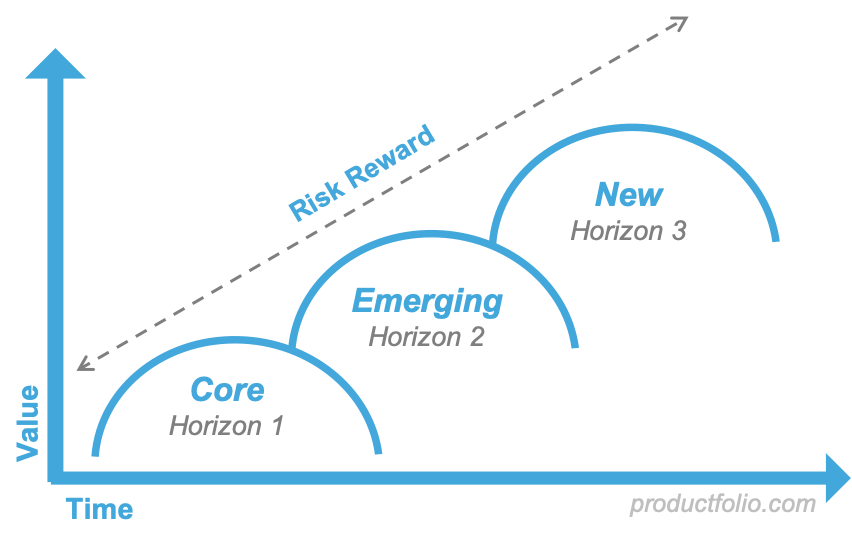What is McKinsey’s 3 Horizons Model?
Businesses that are looking to achieve and maintain long-term growth must give due attention to existing products while also not overlooking innovation. The 3 Horizons framework by the international management consulting firm McKinsey provides some help on how to be effective at this.

What is the 3 Horizons Model?
First presented in The Alchemy of Growth, this model provides a method for thinking strategically about a company’s future. The framework aims to help manage present performance while also making the most of potential future opportunities for growth. It identifies three horizons across which organizations should share out its investments.
The 3 Horizons model was the result of years of research into how successful businesses sustain long-term growth. It is a favorite of many professionals and executives that have an interest in innovation for growth. Although developed in the 20th Century, the framework remains relevant today, especially when faced with uncertainty.
The Model Explained
Sometimes also referred to simply as the ‘Horizon Model’, this framework features Time on the x-axis and Value on the y-axis. It categorizes business goals, ventures, or activities into horizons in a step-like fashion, with movement from one to another over time. McKinsey notes that the Time axis does not indicate when to give attention to each horizon but instead implies the cycle in which businesses operate. The Value axis suggests the growth in value that may be achieved by giving attention to all horizons.
What does each of these horizons relate to?
Horizon One – This has to do with the core business of a company at present. It focuses on ideas that help to improve an existing business model and key capabilities in the short term. The goal is to maximize performance and improve cash flow and profits.
Horizon Two – The innovations here relate to emerging opportunities for a business. The aim in this horizon is to extend your core business into new areas or to new targets. It requires a shift of focus to promising projects or initiatives that require significant investment but are capable of delivering sizeable returns along the line.
Horizon Three – Here you have innovation ideas that entail creating a new business model or new capabilities. These ideas are usually unproven and potentially disruptive. If not disruptive, they may be a response to opportunities that are. These innovations typically take 5-12 years to return a profit.
How Does the 3 Horizons Model Help?
This McKinsey framework suggests how a company cannot afford to ignore either existing businesses or the need for innovation in its growth efforts. It helps you to strike a balance between focusing on today and the future. You can find the tool greatly useful for working out the strategies that can help ensure sustainable long-term growth.
While most companies realize the importance of innovation, they often fail to give it due attention. It is easy for organizations to become overly engrossed with Horizon One businesses with little thought for the future. The 3 Horizons model can help to deal with this issue.
The framework is perfect for promoting team alignment. It helps to make sure everything is clear to stakeholders and ensure that everyone is on the same page. Discussions on what growth strategies to pursue can become easier with the model. It may especially be beneficial in large organizations in which there is a greater tendency for disparate opinions and visions.
McKinsey’s 3 Horizons may not only be ideal for growth strategy but also portfolio management. It offers a simple approach for conveying the plans a company has for its today and future.
How to Use the Framework
The 3 Horizons model provides you with a great structure for managing both current and future opportunities simultaneously for growth. Executive-level managers can use it as a blueprint for doing this effectively. What’s the best way to use this framework for sustainable long-term growth?
You need to start by determining the horizons which the projects in your growth strategy match. What’s the estimated length of time it will take to see results? What are your best-performing products or businesses at present?
It helps for a company to have an idea of what would be needed in the future to maintain growth. This means putting things in place to ensure that it does not go under if the existing businesses were to go awry. It entails identifying profitable future ideas and opportunities to work towards – Horizon Three ideas.
With the above already taken care of, you need to work out your transition from one horizon to the other in due course. Investments should be spread across the three horizons without leaving out anyone. The recommendation is to devote the largest share to Horizon One innovations, which are critical for survival. Projects or activities in Horizon Two take the second-largest share while the remainder goes to Horizon Three initiatives.


